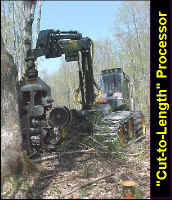

Home Page |
MICHIGAN FORESTS FOREVER TEACHERS GUIDE
| MOVING WOOD FROM THE FOREST TO THE MILL |  |
Most timber harvesting is done under a timber sales contract. Contracts vary widely. The federal government has a very long contract with many appendices, most of which don't deal specifically with the timber sale but more with background information and legal issues. Contracts with private forestowners tend to be only a few pages and reflect the kind of job that the forestowner wants to have done.
Stumpage is the price of standing timber, before the trees are harvested. The person or group that owns the trees receives the stumpage payment from the logging contractor. Private forestowners too often don't think about the impact their stumpage income will have on federal income taxes. This is a specialized area of Internal Revenue Service codes. The value of stumpage will vary considerably with the tree species, product, location, season, market conditions, contractor equipment, distance to a paved road, and many other factors. There is no set price or commodity listing. To obtain the highest price for a particular stand of trees, timber sales are professionally bid out, usually by foresters. In the case of private sales, this process is best handled by a forestry consultant, unless the landowner has experience in this area. Of course, the highest bidder may NOT be the best choice for a particular sale. Logging contractors don't all have the same equipment and experience.
Today, there are many kinds of equipment and combinations of equipment used to harvest timber. Chainsaws are not used to harvest most of Michigan's trees. Those days, too, are mostly behind us. Most of the operation is done with machines. This is safer for the logger and modern harvesting systems are more productive and efficient. They are also "lighter on the land" than historical logging techniques. However, the harvesting machines may cost a half-million dollars or more!
|
|
 Another
harvesting system combines a "processor" with a "forwarder".
These are referred to as "cut-to-length" systems and are used to harvest the majority of timber volume in Michigan. A processor is a large
machine that grabs, fells, and "bucks" trees to specified lengths. There
are no chainsaws involved, except that on the processor "head". The processor leaves piles of logs in the woods which a
forwarder will pick up and take to the landing. A forwarder is a machine with a
mechanical arm and log bunk. An "iron mule" is a common forwarder used in
Michigan. Another
harvesting system combines a "processor" with a "forwarder".
These are referred to as "cut-to-length" systems and are used to harvest the majority of timber volume in Michigan. A processor is a large
machine that grabs, fells, and "bucks" trees to specified lengths. There
are no chainsaws involved, except that on the processor "head". The processor leaves piles of logs in the woods which a
forwarder will pick up and take to the landing. A forwarder is a machine with a
mechanical arm and log bunk. An "iron mule" is a common forwarder used in
Michigan.
More common in the Lower Peninsula than in the U.P., is whole-tree skidding. The entire tree, sometimes with the branches and sometimes without, is pulled (or "skidded") from the woods to a landing. The entire bole or trunk is then loaded onto a truck and driven to the mill. Many of our utility pole and sawmill companies accept "whole tree" loads. This practice is especially common in northern Minnesota for delivery to pulp mills and OSB (oriented strand board) mills. Trees might also be chipped at the landing with the chips to be used for a variety of purposes. This practice is increasingly common in the southern states, but can be found around certain Michigan mills. There are other kinds of harvesting systems in Michigan and even more in other regions of the country. Systems develop from the needs of area wood-using mills and the traditions that vary from region to region. |

|
|
In the forested areas of
Michigan, it is common to see logging trucks moving wood from the forest to
the mill. We have over 700 logging and trucking companies that move wood to
about 300 wood-using mills. Michigan's extensive road system allows this
to happen. Most of Michigan's wood is transported by truck
Railroads are also used to transport wood, especially over longer distances. Pulpwood might be brought to Michigan from Ontario, or high quality Michigan veneer logs might be sent to mills anywhere in the Midwest or beyond. Log buyers from other countries arrange for logs to be transported by ship. The Great Lakes and St. Lawrence Seaway make this possible. Truckers pick up logs in the forest at places called "landings". Landings are small clearings where loggers gather the logs. At the landings, the logs are loaded onto flat-bed trailers. Often, the trailers are equipped with a mechanical claw that can pick up and load many logs at once. Operators can load an entire truck with about 15-20 cords in less than 60 minutes. Logs are carefully chained into place so they do not shift during transport to the mill. From the landing, the truck must move slowly along rough forest roads until it reaches a good graveled road or a paved road. Once on a good road, the driver might travel a hundred miles or more to deliver the wood. However, trucking distances are usually less than that. Logs that are worth a lot of money can be transported farther, because the cost of the trucking is smaller compared to the high value of the logs. Pulpwood and other low-value material is less valuable, making transportation a proportionately higher part of the cost to the mill.
|
|
|
 |
This website was developed and created by Michigan State University Extension for the teachers of the State of Michigan. |